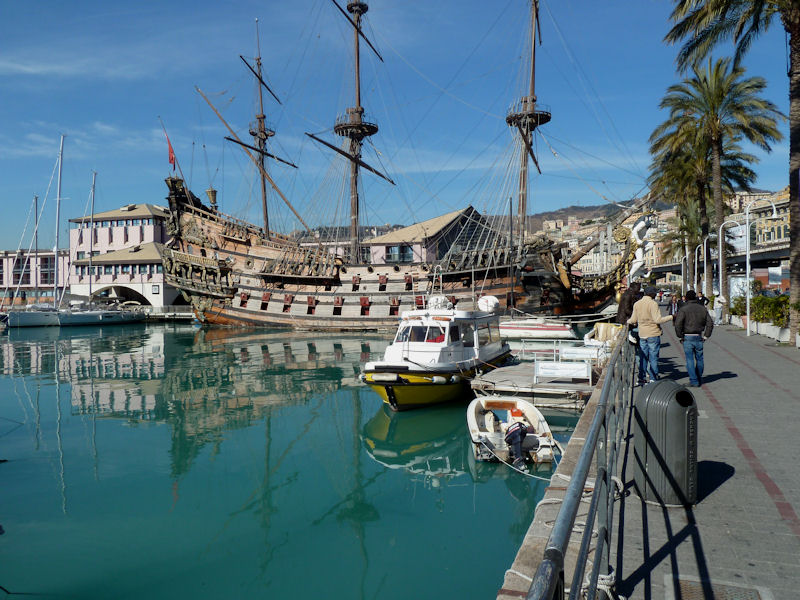 Via Garibaldi and Genoese palaces
Via Garibaldi and Genoese palaces
In the mid-sixteenth century, as soon as the fortunes of Genoese bankers proved sufficient, to allow them to move out of the cramped Old Town, the artisan houses were demolished and a new street called Strada Nuova was created, later named Via Garibaldi. A walk down this street is similar to browsing a Renaissance architect's notebook. The facades of the three-story palaces are decorated with carvings, with stucco and medallions, and the internal courtyards are more like private squares in size. It is worth checking e.g.. pod # 7, to the 16th-century Palazzo Podesta, with a grotto and a fountain. On the ground floor of some palaces there are snobbish antique shops etc., but most of it was turned into commercial offices and administrative premises.
Two of the palaces on Via Garibaldi have been turned into art galleries. W White Palace (Tue-Sat. 9.00-13.00 i 15.00-18.00, nd. 9.00-12.45; 2000 L) houses a collection of paintings by Genoese and other artists, who spent some time in the city. So there are paintings by Van Dyck and Rubens, as well as a good overview of Flemish art. It is worth looking at the portrait of Genoa reigning in the year 1528 Andrei Doria, by Jan Matsys. Doria became famous and enriched himself by attacking the Turkish fleet and pirate ships in the Mediterranean Sea, but just the physical experience of many years in Genoa, which required a lot of cleverness and courage, claim to fame enough. These traits enabled him to survive numerous conspiracies on his life, many of which were initiated by members of the Fieschi family.
On the opposite side of the street, w Palazzo Rosso (Tue-Sat. 9.00-13.00 i 15.00-18.00, nd. 9.00-12.45; 2000 L), houses a collection of paintings by Titian, Caravaggia and Diirera. However, the interior design is more interesting than the paintings themselves, which drips from gilding and is full of fancy chandeliers, chandelier and frescoes on the ceilings. An interesting specialty of the museum is the large collection of birth scenes.
Royal Palace (wt., Wed, sb. i nd. 9.00-13.00; 2000 L), located about a kilometer away, on Via Balbi, is next, a palace in Genoa worth a visit. From glazed galleries and arched windows, of which today you can only see large container ships, there used to be a view of the sea. The building has an atmosphere of a summer holiday palace. It is also created by the decor: flexible wooden floor in the ballroom, joyful, light decoration, and rococo ceilings, full of figures floating in the air. There is also a small collection of paintings upstairs.
Port
Equipped with docks and railway sidings, the port basins extend west as far as the airport. The shipbuilding and steel industry developed here from the beginning of this century, creating the main driving wheels of the Italian industrial revolution. However, the recession in recent years has brought significant unemployment. Built in the fin-de-sicle style of the Stazione Marritima, from which steamboats used to depart to New York and Buenos Aires, today it is a haven for ferries operating on shorter routes, to Corsica, Sardinia and Sicily. In the port, it is worth seeing Lantema - built in the year 1544 Beacon, oraz Molo Vecchio, where was blessed, and then the condemned were hanged. Every day approx. 14.00 Co-operative Battelieri (• 265712) organizes guided tours of the port for tourists (3500 L).
Located in front of the Ponte dei Mille ferry terminal (The Thousand Bridge) got its name thanks to the event, which took place here during the unification of Italy. This is where the former mercenary and spaghetti seller are, the most famous partisan leader of the 19th century, Giuseppe Garibaldi, loaded his thousandth, but armed with just a few rifles and without ammunition, the Red Shirt army, and on board two rickety wheelers (paddle wheel steamers) set off on a cruise to Sicily. The tasks of this army: support for the local revolution and the unification of Sicily with the states of the Italian peninsula, they were very displeasing to some politicians of the North, who wanted nothing to do with the underdeveloped South. They were not the only ones who disliked Garibaldi's plan. Mazzini himself called the finally reunited Italy "a lifeless mosaic […] ruled by a few rich people ", where most of the citizens were outside the limits of politics, and was under the dominant influence of the Catholic Church.